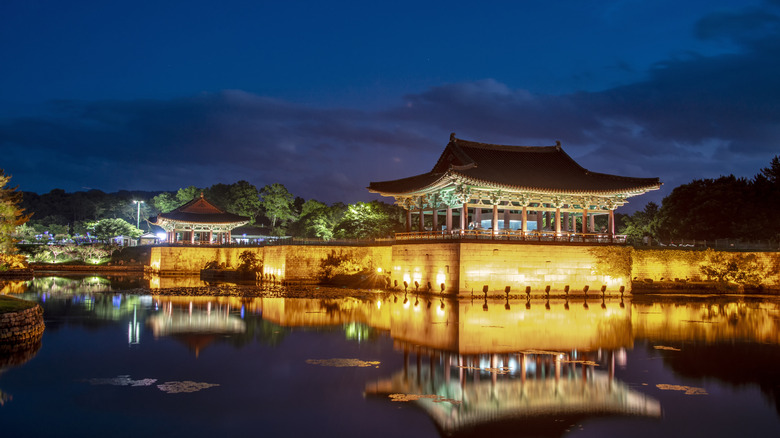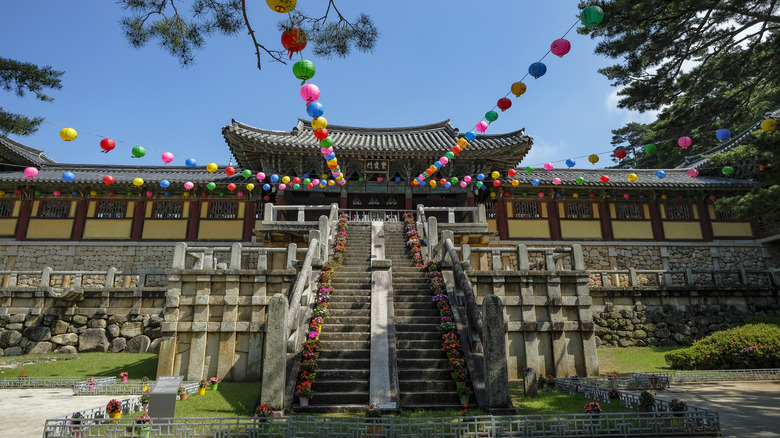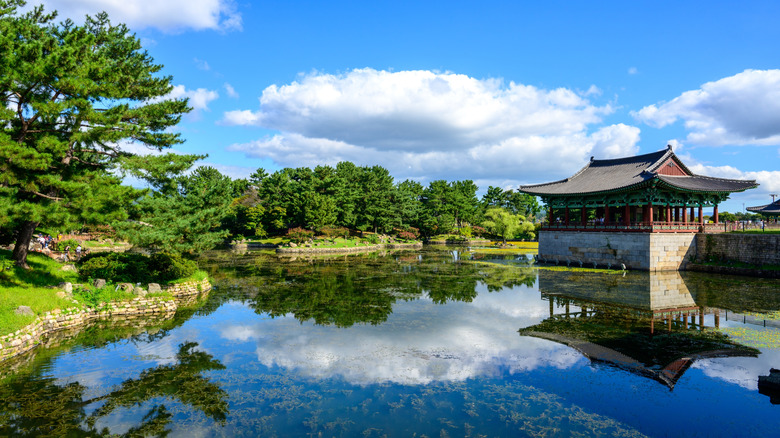South Korea's 'Museum Without Walls' Is A Unique City Brimming With Buddhist Temples And Palaces
If you're looking for a bucket list destination with fascinating cultural experiences and gorgeous scenery, look no further than South Korea. The Asian country is alive with vibrant cities like Seoul and Busan, as well as breathtaking natural scenery in spots like Jeju Island, the most beautiful island in South Korea. For many travelers, no other place in South Korea exemplifies all of these things quite like Gyeongju, a city that is so culturally and historically important to the country that it has been nicknamed the "Museum Without Walls" and is a designated UNESCO World Heritage Site.
Gyeongju is located in the southeastern region of South Korea. The city is over two hours away via public transit from the city of Daegu and about an hour and a half away from the bustling city of Busan. Busan is served by Gimhae International Airport, where you can catch a bus to Gyeongju or pay for a car to drive you there. Travelers also have the option to take a high-speed train from Seoul to Gyeongju, which takes about two and a half hours.
Since many of the attractions in Gyeongju involve being outdoors, it's best to visit in the spring or fall when the weather is a little more temperate, as summers can be pretty hot. Since Gyeongju is a well-visited place with convenient transit options, it makes for a great day trip for travelers basing themselves in Busan or a weekend trip for those visiting from Seoul. Some past travelers suggest staying for at least two or three days to truly experience all that Gyeongju has to offer, and there are plenty of hotels and guesthouses in the city for overnight stays.
Gyeongju has a wealth of incredible historical and cultural attractions
The Gyeongju Historic Areas are listed as a UNESCO World Heritage Site, and they contain five distinct sites: the Bulguksa Temple and Seokguram Grotto, the Mount Namsan Belt, the Wolseong Belt, the Tumuli Park Belt, the Hwangnyongsa Belt, and the Sanseong Fortress Belt. Gyeongju's many temples and palaces, especially the Bulguksa Temple, are the premier reasons why travelers flock there to admire the beautiful architecture and take in the deep cultural significance. The city itself has existed for 2,000 years (when it was part of the Silla kingdom), and many of its museums and sites still hold artifacts from this ancient past. Bulguksa is a Buddhist temple that dates back to A.D. 751, and its construction was inspired by the Buddhist depiction of paradise. Seokguram, the nearby man-made grotto, houses a statue of Buddha as well as representations of Buddhist figures.
There are other temples and ancient palace sites around the area, such as the Golgusa Temple, Bunhwangsa Temple, Hwangnyongsa Temple ruins, Donggung Palace, and the Daereungwon Tomb Complex (tombs for kings that look as if they're growing out of the hillside). The Wolseong Belt also includes the ruins of the Wolseong Palace (which date back to Gyeongju's beginnings), the Cheomseongdae Observatory, and the surrounding natural areas. Throughout the city, especially in the Mount Namsan Belt, visitors can see 64 ancient pagodas, over 50 Buddhist statues, and 122 temple ruins that harken back to the city's past, which is how Gyeongju earned its nickname. As with any place of worship, it's important to observe the unspoken etiquette rules you need to know before entering a Buddhist temple. Of course, visitors should also stop by the Gyeongju National Museum to see even more fascinating artifacts.
Gyeongju's beautiful, natural scenery is also an unforgettable experience
Since Gyeongju's UNESCO World Heritage Sites also account for natural areas, the city is well known for its beautiful, verdant scenery. Part of the Wolseong Belt includes the surrounding forest and Wolji Pond, which both have ties to local history. Wolji Pond (also referred to as Anapji Pond) is an artificial body of water that dates back to A.D. 674 to celebrate peace between the kingdoms that controlled the area at the time. Its tranquil waters and beautiful greenery (including lotus flowers) make it the perfect place to reflect. The still waters are especially beautiful at night when the palace is lit up. In the fall, visiting the Cheomseongdae Observatory allows you to see the pink muhly grass that grows in the area.
One of the best ways to see Gyeongju is to hire a guide to take you to the various temples and palaces or even rent a bike to see all the historic areas yourself with ease. You can find lots of tours on sites like Trip Advisor that often group together several sites so you can easily navigate throughout Gyeongju without much trouble. And, of course, the city isn't just made up of historical sites — visitors can also find plenty of places to shop for souvenirs and eat local foods like tasty flower-printed pastries, bulgogi beef, and rice wine. Some travelers have noted that the street food is very good and budget-friendly in Gyeongju, but be wary of places that might inflate their prices when catering to tourists. If you're planning a trip to South Korea, check out our guide on the best lesser-known destinations around Asia.


